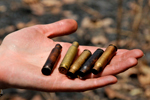
A scene of terror: the bodies of 89 elephants were found in Chad following a massacre by poachers. Photo courtesy of SOS Elephants in Chad.
In what is being called the worst elephant massacre in Africa this year, poachers have recently killed as many as 89 elephants in Chad. Stephanie Vergniault, the Chairman of SOS Elephants in Chad, says the elephants were slaughtered in a two-day period late last week near Tikem, on the southwest border of Chad and Cameroon. At least 30 of the elephants were pregnant. Images from a television news report show what appear to be an elephant still connected to its umbilical cord on the ground. Separately, 12 calves were also slaughtered.
Vergniault was informed of the massacre by her Chad-based staff as well as government officials. The poachers, suspected to be Sudanese or Chadian, were heavily armed and on horseback. Vergniault says as many as 50 poachers were involved in the massacre. Large numbers of poachers had been spotted in Chad in January; Chad’s Minister of Environment was reportedly informed about their presence at that time. Vergniault says the poachers are now heading to an area closer to the border of Cameroon where she says an upwards of 800 elephants remain unprotected.
Celine Sissler-Bienvenu, Director of France and Francophone Africa for the International Fund for Animal Welfare (IFAW) says that local communities had been asking Chadian authorities for help in resolving local elephant conflict. However, no support was provided “which may be why the elephant massacre was not reported for some days. The killing of the elephants by poachers may have been seen as offering some sort of relief to local farmers who are unable to protect their crops and livelihoods randomly being damaged by elephant herds simply looking for food.” Sissler-Bienvenu says the area in which the elephants were killed—like many areas in Chad where elephants roam—was not protected.
Nicole Mollo, US-based Director of Operations of African Parks, a non-profit organization which rehabilitates and reinforces struggling national parks, says the slaughter near Tikem is, unfortunately, “very typical of the trend we are seeing and will continue to see until all of Africa’s elephants are gone—unless our methods of protection change. [As it pertains to current conservation practices], the status quo is not working.”
It is unclear where the poachers are at this time. There are no reports of any arrests. Chad authorities have denounced the massacre, which comes on the heels of a recent slaughter of elephants in Cameroon, which left 28 elephants dead.
The ivory from the elephants will most likely be illegally exported to Thailand or China, where it is used to make jewelry, figurines, and souvenir trinkets.
China is one of eight nations currently put on a “watch list” at CITES (Convention for International Trade in Endangered Species), which recently ended its global summit. CITES asked these countries—including Thailand, Vietnam, Philippines, Malaysia, Kenya, Tanzania, and Uganda—to submit detailed plans on how they will stop the current ivory trade. Progress must be made by 2014.
Other countries, however, like Cameroon, Democratic Republic of Congo (DRC) and Chad, did not get highlighted by CITES, although this is where a most significant amount of poaching in Africa occurs. A number of conservation organizations found CITES steps wholly inadequate; Rosalind Reeve with the David Shepherd Wildlife Foundation said, “Its failure to combat the fundamental driver of the killing amounts to gross international negligence.”

Dead mother with calf still attached to umbilical cord. The Chairman of SOS Elephants Chad, Stephanie Vergniault, told mongabay.com that this calf was likely born during the shooting attach by poachers only to perish. Photo courtesy of SOS Elephants in Chad.

Officials stand next to the body of slaughtered elephant, one of some seven dozen. Photo courtesy of SOS Elephants in Chad.
Related articles
Elephant woes: conservationists mixed on elephant actions at CITES

(03/14/2013) Conservationists couldn’t agree if the glass was half-full or half-empty on action to protect elephants at the Convention on International Trade in Endangered Species (CITES) in Bangkok, Thailand. Elephants, especially in Africa, have faced a massive rise in poaching over the last decade with tens-of-thousands shot dead every year. Forests elephants in central Africa have been especially targeted: new research estimates that an astounding 60 percent of the world’s forest elephants have been slaughtered for their tusks in the last ten years alone. While conservationists had hopes that CITES would move aggressively against elephant poaching, the results were a decidedly mixed-bag.
Prayers for dying elephants: Buddhists hold prayer ceremony for elephants decimated by poachers

(03/11/2013) Buddhist leaders prayed for slaughtered African elephants in Bangkok, Thailand last week, reports WWF. During a special merit-making ceremony, often reserved for the recently deceased, Buddhist monks, abbots, and leaders prayed for the tens-of-thousands of elephants that have been killed for their ivory tusks. Bangkok is currently hosting an international meeting of the Convention on International Trade in Endangered Species (CITES), where the elephant crisis is being discussed.
Seeing the forest through the elephants: slaughtered elephants taking rainforest trees with them

(03/11/2013) Elephants are vanishing. The booming illegal ivory trade is decimating the world’s largest land animal, but no place has been harder hit than the Congo basin and its forest elephants (Loxodonta cyclotis). The numbers are staggering: a single park in Gabon, Minkebe National Park, has seen 11,100 forest elephants killed in the last eight years; Okapi Faunal Reserve in the Democratic Republic of the Congo has lost 75 percent of its elephants in fifteen years; and a new study in PLoS ONE estimates that in total 60 percent of the world’s forest elephants have been killed in the last decade alone. But what does that mean for the Congo forest?
What happened to the elephants of Bouba Ndjida? [warning: graphic photos]

(03/07/2013) A new report released by the Wildlife Conservation Society says that poachers have killed a staggering 62 percent of Africa’s forest elephants in the last decade. The insatiable demand for elephant ivory hails mainly from China and Thailand, which is ironically hosting this year’s CITES (CoP16) meeting. The meeting will continue until March 13 2013. The study is based on a survey of five elephant range states including Cameroon. Cameroon is the home of Bouba Ndjida National Park, where the dizzying massacre of 650 elephants occurred last year.
62% of all Africa’s forest elephants killed in 10 years (warning: graphic images)
(03/04/2013) More than 60 percent of Africa’s forest elephants have been killed in the past decade due to the ivory trade, reports a new study published in the online journal PLOS ONE. The study warns that the diminutive elephant species — genetically distinct from the better-known savanna elephant — is rapidly heading toward extinction.
Thailand’s Prime Minister commits to ending ivory trade

(03/04/2013) Yesterday, Thailand’s Prime Minister, Yingluck Shinawatra, committed to ending the ivory trade in her country. Her announcement came during the opening of the Convention on the International Trade in Endangered Species of Fauna and Flora (CITES) in Bangkok, which seeks to regulate trade in biodiversity across borders. Wildlife groups say that Thailand’s legal trade in domestic ivory—international ivory is illegal of course—has created an easy opening for smugglers from abroad. Currently the ivory trade in Thailand is estimated to be second only to that of China.
